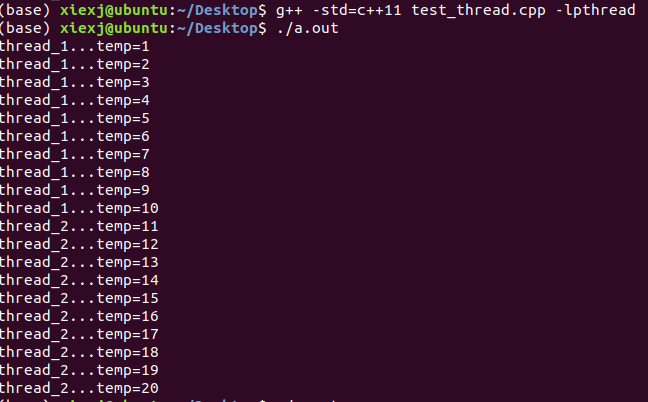参考:
5.github:
如果第一次接触,直接看我给的参考即可,看过了之后,我把我觉得ok的重点总结在了下面
-----------------------------------------------------笔记--------------------------------------------------
博客一:(一个简单例程+makefile)

#include <stdio.h>
#include <stdlib.h>
#include <iostream> // std::cout
#include <thread> // std::thread
void thread_task() {
std::cout << "hello thread" << std::endl;
}
/*
* === FUNCTION =========================================================
* Name: main
* Description: program entry routine.
* ========================================================================
*/
int main(int argc, const char *argv[])
{
std::thread t(thread_task);
t.join();
return EXIT_SUCCESS;
} /* ---------- end of function main ---------- */

all:Thread
CC=g++
CPPFLAGS=-Wall -std=c++11 -ggdb
LDFLAGS=-pthread
Thread:Thread.o
$(CC) $(LDFLAGS) -o $@ $^
Thread.o:Thread.cc
$(CC) $(CPPFLAGS) -o $@ -c $^
.PHONY:
clean
clean:
rm Thread.o Thread
博客二:(算是cplusplus官网给的.join()例子的扩充,挺好的)(也有其他函数的官网链接)

#include <stdio.h>
#include <stdlib.h>
#include <chrono> // std::chrono::seconds
#include <iostream> // std::cout
#include <thread> // std::thread, std::this_thread::sleep_for
void thread_task(int n) {
std::this_thread::sleep_for(std::chrono::seconds(n));
std::cout << "hello thread "
<< std::this_thread::get_id()
<< " paused " << n << " seconds" << std::endl;
}
/*
* === FUNCTION =========================================================
* Name: main
* Description: program entry routine.
* ========================================================================
*/
int main(int argc, const char *argv[])
{
std::thread threads[5];
std::cout << "Spawning 5 threads...
";
for (int i = 0; i < 5; i++) {
threads[i] = std::thread(thread_task, i + 1);
}
std::cout << "Done spawning threads! Now wait for them to join
";
for (auto& t: threads) {
t.join();
}
std::cout << "All threads joined.
";
return EXIT_SUCCESS;
} /* ---------- end of function main ---------- */
结果是隔一秒打印一行
其他成员函数
- 获取线程 ID。
- 检查线程是否可被 join。
- Join 线程。
- Detach 线程
- Swap 线程 。
- 返回 native handle。
- 检测硬件并发特性。
博客三:(有一个使用互斥量的例子,介绍了volatile关键字)
如果该线程是在同一类的某一成员函数当中被构造,则直接用this关键字代替即可。
这里使用this指针代替实例化对象的地址

#include<iostream>
#include<thread>
#include<mutex>
std::mutex mut;
class A{
public:
volatile int temp;
A(){
temp=0;
}
void fun(int num){
int count=10;
while(count>0){
mut.lock();
temp++;
std::cout<<"thread_"<<num<<"...temp="<<temp<<std::endl;
mut.unlock();
count--;
}
}
void thread_run(){
std::thread t1(&A::fun,this,1);
std::thread t2(&A::fun,this,2);
t1.join();
t2.join();
}
};
int main(){
A a;
a.thread_run();
}

参考五:(hardware_concurrency)
检测硬件并发特性,返回当前平台的线程实现所支持的线程并发数目,但返回值仅仅只作为系统提示(hint)。
#include <iostream> #include <thread> int main() { unsigned int n = std::thread::hardware_concurrency(); std::cout << n << " concurrent threads are supported. "; }
![]()
虚拟机设置为2核,支持两个线程并发

